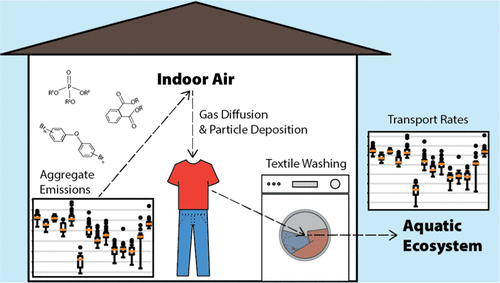当前位置:
X-MOL 学术
›
Environ. Sci. Technol.
›
论文详情
Our official English website, www.x-mol.net, welcomes your feedback! (Note: you will need to create a separate account there.)
Textile Washing Conveys SVOCs from Indoors to Outdoors: Application and Evaluation of a Residential Multimedia Model
Environmental Science & Technology ( IF 11.4 ) Pub Date : 2021-09-02 , DOI: 10.1021/acs.est.1c02674 Jacob Kvasnicka 1 , Elaine A Cohen Hubal 2 , Timothy F M Rodgers 3 , Miriam L Diamond 1, 3, 4, 5
Environmental Science & Technology ( IF 11.4 ) Pub Date : 2021-09-02 , DOI: 10.1021/acs.est.1c02674 Jacob Kvasnicka 1 , Elaine A Cohen Hubal 2 , Timothy F M Rodgers 3 , Miriam L Diamond 1, 3, 4, 5
Affiliation

|
Indoor environments have elevated concentrations of numerous semivolatile organic compounds (SVOCs). Textiles provide a large surface area for accumulating SVOCs, which can be transported to outdoors through washing. A multimedia model was developed to estimate advective transport rates (fluxes) of 14 SVOCs from indoors to outdoors by textile washing, ventilation, and dust removal/disposal. Most predicted concentrations were within 1 order of magnitude of measurements from a study of 26 Canadian homes. Median fluxes to outdoors [μg·(year·home)−1] spanned approximately 4 orders of magnitude across compounds, according to the variability in estimated aggregate emissions to indoor air. These fluxes ranged from 2 (2,4,4′-tribromodiphenyl ether, BDE-28) to 30 200 (diethyl phthalate, DEP) for textile washing, 12 (BDE-28) to 123 200 (DEP) for ventilation, and 0.1 (BDE-28) to 4200 (bis(2-ethylhexyl) phthalate, DEHP) for dust removal. Relative contributions of these pathways to the total flux to outdoors strongly depended on physical–chemical properties. Textile washing contributed 20% tris-(2-chloroisopropyl)phosphate (TCPP) to 62% tris(2-butoxyethyl)phosphate (TBOEP) on average. These results suggest that residential textile washing can be an important transport pathway to outdoors for SVOCs emitted to indoor air, with implications for human and ecological exposure. Interventions should try to balance the complex tradeoff of textile washing by minimizing exposures for both human occupants and aquatic ecosystems.
中文翻译:

纺织品洗涤将 SVOCs 从室内传递到室外:住宅多媒体模型的应用与评估
室内环境中大量半挥发性有机化合物 (SVOC) 的浓度升高。纺织品为积累 SVOCs 提供了很大的表面积,可以通过洗涤将其输送到户外。开发了一个多媒体模型,通过纺织品洗涤、通风和除尘/处理来估计 14 种 SVOC 从室内到室外的平流传输率(通量)。大多数预测的浓度都在 26 个加拿大家庭的测量值的 1 个数量级以内。到室外的通量中值 [μg·(年·家) -1] 根据估计的室内空气总排放量的可变性,化合物的范围跨越了大约 4 个数量级。这些助焊剂的范围从 2(2,4,4'-三溴二苯醚,BDE-28)到 30200(邻苯二甲酸二乙酯,DEP)用于纺织品洗涤,12(BDE-28)到 123200(DEP)用于通风,0.1 (BDE-28) 至 4200(邻苯二甲酸二(2-乙基己基)酯,DEHP)用于除尘。这些路径对户外总通量的相对贡献很大程度上取决于物理化学性质。纺织品洗涤平均贡献了 20% 的磷酸三(2-氯异丙基)酯(TCPP)到 62% 的磷酸三(2-丁氧基乙基)酯(TBOEP)。这些结果表明,住宅纺织品洗涤可能是排放到室内空气中的 SVOCs 到室外的重要运输途径,对人类和生态暴露有影响。
更新日期:2021-09-21
中文翻译:

纺织品洗涤将 SVOCs 从室内传递到室外:住宅多媒体模型的应用与评估
室内环境中大量半挥发性有机化合物 (SVOC) 的浓度升高。纺织品为积累 SVOCs 提供了很大的表面积,可以通过洗涤将其输送到户外。开发了一个多媒体模型,通过纺织品洗涤、通风和除尘/处理来估计 14 种 SVOC 从室内到室外的平流传输率(通量)。大多数预测的浓度都在 26 个加拿大家庭的测量值的 1 个数量级以内。到室外的通量中值 [μg·(年·家) -1] 根据估计的室内空气总排放量的可变性,化合物的范围跨越了大约 4 个数量级。这些助焊剂的范围从 2(2,4,4'-三溴二苯醚,BDE-28)到 30200(邻苯二甲酸二乙酯,DEP)用于纺织品洗涤,12(BDE-28)到 123200(DEP)用于通风,0.1 (BDE-28) 至 4200(邻苯二甲酸二(2-乙基己基)酯,DEHP)用于除尘。这些路径对户外总通量的相对贡献很大程度上取决于物理化学性质。纺织品洗涤平均贡献了 20% 的磷酸三(2-氯异丙基)酯(TCPP)到 62% 的磷酸三(2-丁氧基乙基)酯(TBOEP)。这些结果表明,住宅纺织品洗涤可能是排放到室内空气中的 SVOCs 到室外的重要运输途径,对人类和生态暴露有影响。


























 京公网安备 11010802027423号
京公网安备 11010802027423号